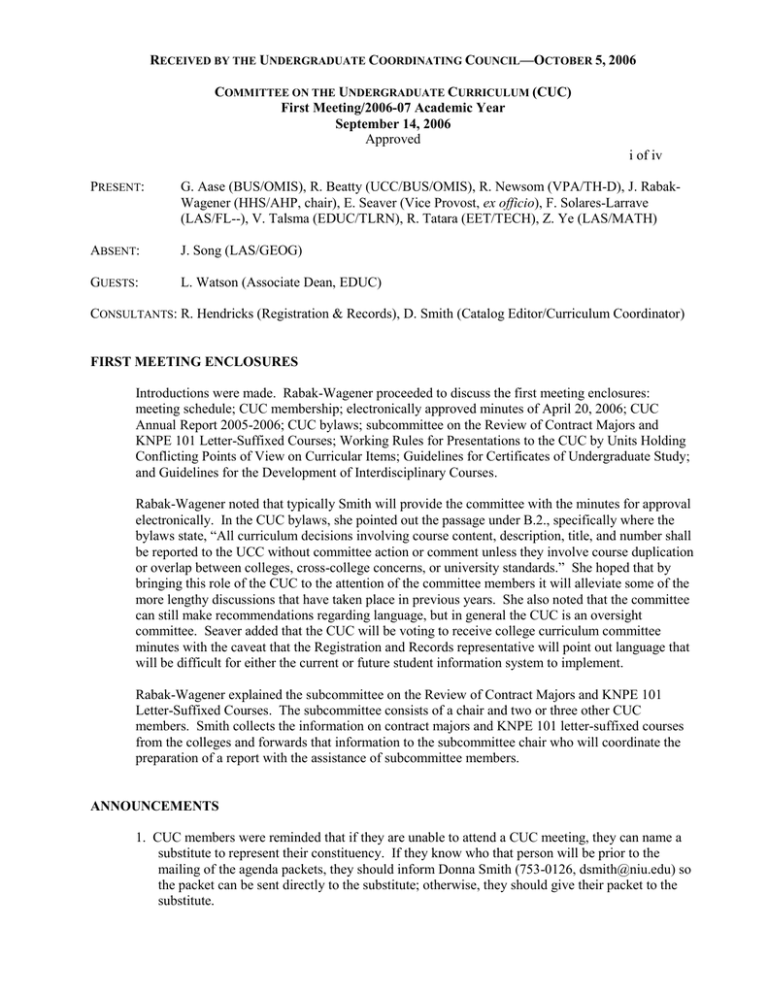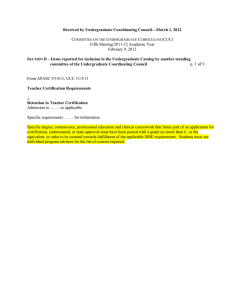Document 15173686
advertisement

RECEIVED BY THE UNDERGRADUATE COORDINATING COUNCIL—OCTOBER 5, 2006 COMMITTEE ON THE UNDERGRADUATE CURRICULUM (CUC) First Meeting/2006-07 Academic Year September 14, 2006 Approved i of iv PRESENT: G. Aase (BUS/OMIS), R. Beatty (UCC/BUS/OMIS), R. Newsom (VPA/TH-D), J. RabakWagener (HHS/AHP, chair), E. Seaver (Vice Provost, ex officio), F. Solares-Larrave (LAS/FL--), V. Talsma (EDUC/TLRN), R. Tatara (EET/TECH), Z. Ye (LAS/MATH) ABSENT: J. Song (LAS/GEOG) GUESTS: L. Watson (Associate Dean, EDUC) CONSULTANTS: R. Hendricks (Registration & Records), D. Smith (Catalog Editor/Curriculum Coordinator) FIRST MEETING ENCLOSURES Introductions were made. Rabak-Wagener proceeded to discuss the first meeting enclosures: meeting schedule; CUC membership; electronically approved minutes of April 20, 2006; CUC Annual Report 2005-2006; CUC bylaws; subcommittee on the Review of Contract Majors and KNPE 101 Letter-Suffixed Courses; Working Rules for Presentations to the CUC by Units Holding Conflicting Points of View on Curricular Items; Guidelines for Certificates of Undergraduate Study; and Guidelines for the Development of Interdisciplinary Courses. Rabak-Wagener noted that typically Smith will provide the committee with the minutes for approval electronically. In the CUC bylaws, she pointed out the passage under B.2., specifically where the bylaws state, “All curriculum decisions involving course content, description, title, and number shall be reported to the UCC without committee action or comment unless they involve course duplication or overlap between colleges, cross-college concerns, or university standards.” She hoped that by bringing this role of the CUC to the attention of the committee members it will alleviate some of the more lengthy discussions that have taken place in previous years. She also noted that the committee can still make recommendations regarding language, but in general the CUC is an oversight committee. Seaver added that the CUC will be voting to receive college curriculum committee minutes with the caveat that the Registration and Records representative will point out language that will be difficult for either the current or future student information system to implement. Rabak-Wagener explained the subcommittee on the Review of Contract Majors and KNPE 101 Letter-Suffixed Courses. The subcommittee consists of a chair and two or three other CUC members. Smith collects the information on contract majors and KNPE 101 letter-suffixed courses from the colleges and forwards that information to the subcommittee chair who will coordinate the preparation of a report with the assistance of subcommittee members. ANNOUNCEMENTS 1. CUC members were reminded that if they are unable to attend a CUC meeting, they can name a substitute to represent their constituency. If they know who that person will be prior to the mailing of the agenda packets, they should inform Donna Smith (753-0126, dsmith@niu.edu) so the packet can be sent directly to the substitute; otherwise, they should give their packet to the substitute. RECEIVED BY THE UNDERGRADUATE COORDINATING COUNCIL—OCTOBER 5, 2006 COMMITTEE ON THE UNDERGRADUATE CURRICULUM (CUC) First Meeting/2006-07 Academic Year September 14, 2006 Approved ii of iv New CUC members should note that the consent agenda is used to expedite the consideration of some college curriculum committee minutes and other straightforward and/or noncontroversial curricular items. If a CUC member has a question/concern about or wants to discuss any item on the consent agenda, he/she should ask to have that item removed from the consent agenda and added to the items for discussion prior to the approval of the consent agenda. Rabak-Wagener asked committee members to review college curriculum committee minutes carefully for any minutes that should be removed from the consent agenda for further discussion. She noted that all of the college curriculum committee minutes with undergraduate items were left off of this first meeting’s consent agenda so that new CUC members could become familiar with the process of reviewing minutes. The CUC is the curricular body for interdisciplinary undergraduate curricular material not located in an academic college or colleges, specifically UNIV 101 and curricular offerings from the Division of International Programs and the Center for Black Studies. This responsibility includes usual curricular activity (new, revised, and deleted courses as well as other catalog changes), general education submissions/resubmissions, and review of these units’ overall curricular offerings. 2. Approval of new general education course for Interdisciplinary Studies—ILAS 100 (GEC 4/27/06; UCC 5/4/06). 3. New Student Information System. Seaver reported on the progress of the implementation of the new student information system, also known as Oracle PeopleSoft. The plan is for the new system to be fully operational by the Fall, 2008, admitting cycle. Work on the conversion began in January, 2006, and has included a fit gap analysis to determine where the gaps are between the catalog and the software. A large number of those issues don’t relate to CUC and will go before the Admissions Policies and Academic Standards Committee (APASC). However, one issue will come before the CUC. The new system cannot accommodate the *400 courses. Seaver proposed a means of revising the course numbers for the *400 courses. Rather than put through a course revision for each affected course, departments/colleges can present a conversion chart that includes what the course number was and what it will be. This would include any renumbering of courses so that the 400 and 500-level courses can have similar numbering (e.g., 411 and 511 rather than 411 and 523). This would not include any course with any other revisions to hours, descriptions, PRQs/CRQs, etc. Under the new system, the curricular approval process needs to be complete by December, 2007, for inclusion in the 2008-09 catalogs, so it’s important that departments begin the discussion soon. Talsma asked if departments also need to be aware of the *400 issue when proposing program changes. Seaver responded affirmatively; that any new curriculum proposals, revisions, etc., will not be allowed if they include a *400 course. Rabak-Wagener received a consensus from committee members that they felt comfortable with the proposal of departments/colleges using a conversion chart to indicate course number changes when a *400 course is involved. RECEIVED BY THE UNDERGRADUATE COORDINATING COUNCIL—OCTOBER 5, 2006 COMMITTEE ON THE UNDERGRADUATE CURRICULUM (CUC) First Meeting/2006-07 Academic Year September 14, 2006 Approved iii of iv CONSENT AGENDA Talsma made a motion, seconded by Newsom, to RECEIVE THE ITEMS ON THE CONSENT AGENDA. The motion passed unanimously. The following college minutes with no undergraduate-level curricular items were so received. College of Business #12 (AY 05-06) College of Business #13 (AY 05-06) College of Business #14 (AY 05-06) College of Visual & Performing Arts #7 (AY 05-06) COLLEGE MINUTES AND OTHER CURRICULAR ITEMS FOR DISCUSSION College of Education, #9 (AY 05-06) Rabak-Wagener pointed out that there are a number of items in these minutes that need the approval of the Committee on Initial Teacher Certification (CITC). Seaver explained that CITC is the oversight committee for the teacher certification program throughout the university and that CITC (through the CITC curriculum committee) reviews these items to ensure that the revisions are acceptable for initial teacher certification. Smith pointed out that CITC received the items in this set of minutes at its 4/14/06 meeting. She also pointed out three items on page 7 that APASC approved on 9/6/06. Seaver noted that any curriculum change involving limited admissions and/or retention needs the approval of APASC. Talsma made a motion, seconded by Newsom, to RECEIVE THE UNDERGRADUATE CURRICULAR ITEMS IN EDUCATION MINUTES #9 (2/21/06). Motion passed unanimously. College of Education, #10 (AY 05-06) Seaver pointed out that normally a set of minutes like these containing nothing controversial would be on the consent agenda. Talsma made a motion, seconded by Aase, to RECEIVE THE UNDERGRADUATE CURRICULAR ITEMS IN EDUCATION MINUTES #10 (3/21/06). Motion passed unanimously. College of Education, #11 (AY 05-06) Talsma made a motion, seconded by Solares-Larrave, to RECEIVE THE UNDERGRADUATE CURRICULAR ITEMS IN EDUCATION MINUTES #11 (4/4/06). Motion passed unanimously. College of Health & Human Services, #14 (AY 05-06) Rabak-Wagener noted that these minutes are off of the consent agenda to point out the CITC items. Smith reported that CITC approved those items on 5/5/06. Hendricks pointed out the revisions to FCNS 489 on page 2 and the fact that these types of PRQs are often difficult to implement in the current Legacy system and have yet to be tested in the PeopleSoft system. There is the potential that these PRQs can slow down the system. She noted that there was no need for the department to make any changes at this time, but suggested that colleges keep this in mind when making course revisions. Seaver stated that the more efficiently the system can operate the better it is for the students. When the system is slow, fewer students can register at a time, lengthening the time it takes to get all students registered in a semester. Talsma made a motion, seconded by Solares-Larrave, to RECEIVE THE UNDERGRADUATE CURRICULAR ITEMS IN HEALTH AND RECEIVED BY THE UNDERGRADUATE COORDINATING COUNCIL—OCTOBER 5, 2006 COMMITTEE ON THE UNDERGRADUATE CURRICULUM (CUC) First Meeting/2006-07 Academic Year September 14, 2006 Approved iv of iv HUMAN SCIENCES MINUTES #14 (4/21/06). The revision to the hours in the B.S. in Nursing was clarified; the department is correcting for changes made last year to course requirements. Motion passed unanimously. College of Visual & Performing Arts, #8 (AY 05-06) The one revision in these minutes is a change to the minimum cumulative GPA required for ARTE 342. Seaver pointed out that APASC approved the limited admissions for Art Education last year and the department is just cleaning up catalog language with the revision. Talsma made a motion, seconded by Aase, to RECEIVE THE UNDERGRADUATE CURRICULAR ITEMS IN VISUAL AND PERFORMING ARTS #8 (5/2/06). Motion passed unanimously. OLD BUSINESS No old business. NEW BUSINESS 1. Add Certificate of Undergraduate Study to the “Definitions of Terms” section, page 7 2006-07 Undergraduate Catalog. Smith reported that she was contacted by HHS Associate Dean Mary Pritchard with the suggestion to add Certificate of Undergraduate Study to the “Definitions of Terms” section in the catalog. The change would bring the undergraduate catalog in line with the graduate catalog as the definition for the Certificate of Graduate Study appears in the “Definitions of Terms” section in that catalog. There was discussion as to whether or not this addition would be repetitive since the definition appears elsewhere in the catalog. Talsma made a motion, seconded by Solares-Larrave, to APPROVE THE ADDITION OF THE DEFINTION OF A CERTIFICATE OF UNDERGRADUAT STUDY TO THE “DEFINITIONS OF TERMS” SECTION OF THE UNDERGRADUATE CATALOG). Motion passed unanimously. 2. Need for additional information on new programs. Smith reported that this issue came out of the Graduate Council Curriculum Committee (GCCC) last year when they were asked to approve a new Ph.D. in Art Education. Those committee members inquired as to whether or not they should be receiving information on a new program in addition to the catalog copy. Smith noted that she checked with Virginia Cassidy’s office on the issue and was advised that it would be helpful to obtain further input from the CUC and GCCC. Rabak-Wagener pointed out the New Program Request form included in the agenda packets. This is what departments complete for new programs and copies could be distributed to the CUC and GCCC to help them make a better informed decision on the approval of new programs. Aase noted that this form does not include anything about assessment despite the fact that the need for more assessment has been emphasized in a number of committees in recent years. Seaver said that he will pass that information on to Cassidy. There was further discussion including the clarification that a new program consists of a new degree, major, or emphasis. Rabak-Wagener asked for the CUC’s feedback and received consensus that members would like to see this additional information if they are asked to approve a new program. RECEIVED BY THE UNDERGRADUATE COORDINATING COUNCIL—OCTOBER 5, 2006 COMMITTEE ON THE UNDERGRADUATE CURRICULUM (CUC) First Meeting/2006-07 Academic Year September 14, 2006 Approved v of iv The meeting was adjourned at 1:40 p.m. The next meeting will be October 12, 2006, 12:30, Altgeld 225. Respectfully submitted, Donna M. Smith
